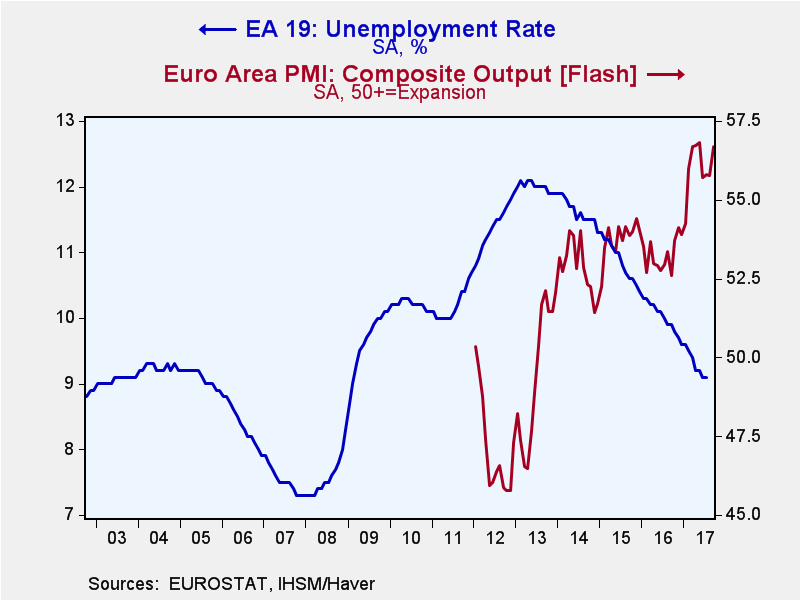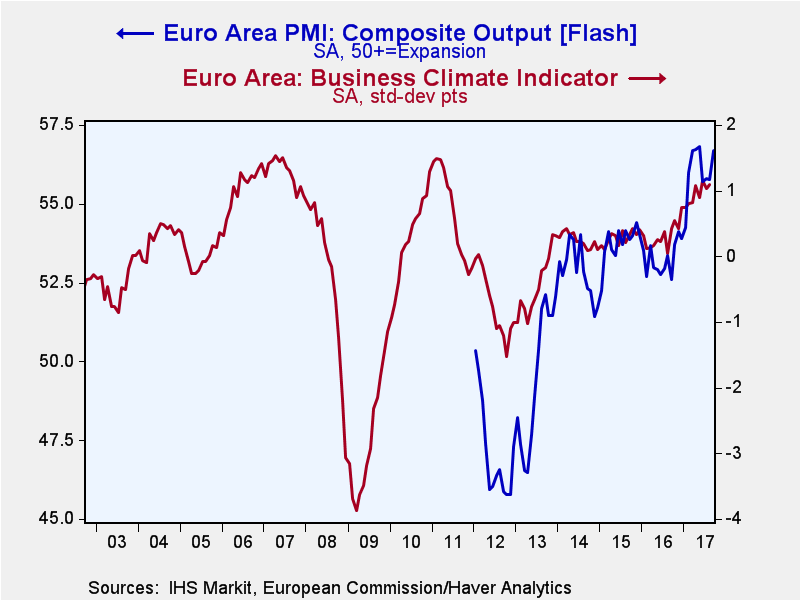 Global| Sep 22 2017
Global| Sep 22 2017EMU PMIs: Manufacturing Pushes Higher As Service Sector Languishes
Summary
Based on the last five and one-half years of data, the EMU region is doing excellently. The EMU region overall and its two largest economies show composite rankings in the mid-to-high 90th percentile of their historic queues of data [...]
Based on the last five and one-half years of data, the EMU region is doing excellently. The EMU region overall and its two largest economies show composite rankings in the mid-to-high 90th percentile of their historic queues of data (5.5 years). By sector, both manufacturing and services are performing well with each sector having its own 90th percentile standing in the EMU as well as in Germany and in France. This is a uniformity of excellence the euro area has not seen for quite some time.
 The short-time horizon on the Markit data in the most generalized database makes it hard to get the right perspective since the last five and one-half years cover the period of recovery and, of course, the EMU and the rest of the global economy have been recovering. But if we splice a companion series on top of the Markit series (the EU Commission business climate indicators for the EMU), we find that the current strong readings from Markit really do have more global implications. The current index readings are not just strong in this cycle, but they are strong in a broader time series sense as well, judging from the EU Commission index for the EMU.
The short-time horizon on the Markit data in the most generalized database makes it hard to get the right perspective since the last five and one-half years cover the period of recovery and, of course, the EMU and the rest of the global economy have been recovering. But if we splice a companion series on top of the Markit series (the EU Commission business climate indicators for the EMU), we find that the current strong readings from Markit really do have more global implications. The current index readings are not just strong in this cycle, but they are strong in a broader time series sense as well, judging from the EU Commission index for the EMU.
While PMI data are getting stronger and look stunning, the EMU unemployment data still are only getting back to more normal levels on unemployment. In some ways, the progress that is measured by the PMIs is simply not trickling through to the rest of the economy. And the unemployment rate is only one of the variables that can be used to demonstrate this. Retail sales not what they used to be and auto registrations are much reduced as well.
There is something about the diffusion data whether from Markit or from the EU Commission or elsewhere that is less than robust in terms of depicting the performance of the entire economy. We are aware that GDP growth in the U.S. and EMU has slowed compared to historic rates of growth. These economies are not performing as they used to; yet, the PMI data have no trouble showing us new and comparable highs on their own relative scales. Workers have dropped out of the labor force making actual welfare conditions across countries even worse than unemployment rates say; yet, the diffusion index view of the world shows us the improving breadth of manufacturing sector and service sector activity.
Of course, PMI gauges chart the progress of survivors. Failed firms do not contribute data. There is a certain bias to this sort of survey for exactly that reason. For example, if we compare the PMI to a labor market report, in the U.S. the Bureau of Labor Statistics (BLS) estimates the 'birth and death' of businesses and the corresponding employment gains and losses from that attrition and addition. It is reasonable to wonder what PMI gauges miss.
It is clear that the PMI view of the world is much more upbeat than the real world- call it an alternate fact if you will. And while I do like these as gauges and find them sensitive to changes in the economy, I also find them lacking in other respects. So when you try to digest the strong readings in the EMU PMIs this month, remember that they tell only part of the story. The ECB has been watching a broader range of data and it is not yet convinced that it is time to take away its special stimulus. Inflation is not percolating even though the PMI gauges' cups runneth over. How could that be consistent with the spectacular new highs we are seeing in the PMI data-sphere? Well, it's because the PMIs do not tell the whole the story. So be careful if 'this is the book that you read from' when you put your children to bed at night, or brief your trading room or inform investors.

Robert Brusca
AuthorMore in Author Profile »Robert A. Brusca is Chief Economist of Fact and Opinion Economics, a consulting firm he founded in Manhattan. He has been an economist on Wall Street for over 25 years. He has visited central banking and large institutional clients in over 30 countries in his career as an economist. Mr. Brusca was a Divisional Research Chief at the Federal Reserve Bank of NY (Chief of the International Financial markets Division), a Fed Watcher at Irving Trust and Chief Economist at Nikko Securities International. He is widely quoted and appears in various media. Mr. Brusca holds an MA and Ph.D. in economics from Michigan State University and a BA in Economics from the University of Michigan. His research pursues his strong interests in non aligned policy economics as well as international economics. FAO Economics’ research targets investors to assist them in making better investment decisions in stocks, bonds and in a variety of international assets. The company does not manage money and has no conflicts in giving economic advice.








